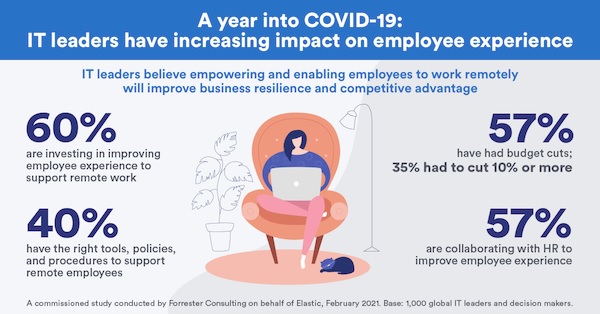

More than half (60%) of IT organizations are investing in improving employee experience to support remote workforce productivity and performance, according to The Changing Role of the IT Leader study by Elastic.

An adaptive business model with employee experience at its core is the key to building business resilience, creating a sustainable competitive advantage, and scaling effectively in times of disruption. Since the start of the COVID-19 pandemic, the shift to remote and hybrid working models has become a permanent fixture for many global organizations. IT leaders believe that enabling employees to work flexibly will improve the adaptiveness of their organizations and they are investing in technology to improve employee experience and productivity.
"One year into the COVID-19 global pandemic, the data shows it's time for IT leaders to put employee experience at the heart of every technology decision they make," said Kim Huffman, VP, IT, Elastic. "They must quickly and dramatically evolve and accelerate their programs as they work to support their employees and adapt to the next normal and a completely different way of working."
Globally, the partnership between IT and HR is growing stronger, with 57% of IT leaders collaborating more closely with their HR counterparts since the start of the pandemic, as also found in the study. While many IT leaders worldwide have pivoted to an employee-centric approach in their technology decisions, they still face barriers to establish an environment where IT fosters engagement and productivity.
"A deep partnership between HR and IT leaders is crucial when it comes to enhancing employee experience, and that partnership has never been more important than it was over the past year," said Leah Sutton, SVP, Global Human Resources, Elastic. "The combined insight and expertise that both leaders bring ensure that employees aren't bouncing around from IT, to HR, to finance, and more. Rather, employees have a holistic corporate experience that ensures they are supported, informed, and empowered with access to the tools and resources they need to successfully do their jobs."
IT leaders report that 92% of organizations worldwide are in survival or maintenance mode
■ In Asia-Pacific, China (21%) and Japan (16%) are leading with the highest number of enterprises in growth mode, while Australia (78%) has the highest number of enterprises in maintenance mode.
■ In Europe, the Netherlands (64%) and Germany (60%) are struggling most, with the highest number of enterprises in survival mode, and 3 in 5 IT leaders in the surveyed countries said their businesses are fighting to survive.
■ In North America only 7% of enterprises are in growth mode, while three times that number are in survival mode.
60% of IT organizations are investing in improving employee experience to support remote workforce productivity and performance, but don't have access to the budget and tools to do so
■ 63% of organizations are prioritizing a shift to digital business by focusing on democratizing employee access to data by evolving their data architectures to reduce data silos.
■ 57% of IT leaders globally have seen their budgets cut over the past 12 months, with 33% experiencing budget cuts of 10% or more.
■ 60% of IT leaders do not yet have the right tools, policies, and procedures to support a remote workforce.
Methodology: For this study, The Changing Role of the IT Leader (April 2021) — commissioned by Elastic — Forrester Consulting conducted a global online survey of 1,000 CIOs and IT decision-makers and select in-depth interviews with CIOs and IT leaders in Australia, China, France, Germany, India, Japan, the Netherlands, North America, Singapore, and the United Kingdom.

